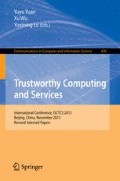Abstract
The main function of CAPCHA is to prevent malicious programs from register or login, malicious irrigation, bag breaking and other network attacks. Most of the current graphic CAPTCHA’s are generated based on numbers or letters by using a random function and then perform distortion or add viscosity curves. These graphic CAPTCHA’s can easily be identified by user, but provides an opportunity for malicious software attack website system. This paper puts forward an algorithm based on multiple layers to generate random Chinese character CAPTCHA’s which has a variety of deformation features. We apply it to dynamic webpage, to ensure the security of land check.
Access this chapter
Tax calculation will be finalised at checkout
Purchases are for personal use only
References
Stallings, W.: Cryptography and Network Security: Principles and Practice. Prentice Hall, New Jersey (1998)
Anderson, R., Needham, R.: Robustness Principles for Public Key Protocols. In: Coppersmith, D. (ed.) CRYPTO 1995. LNCS, vol. 963, pp. 236–247. Springer, Heidelberg (1995)
Cookie source code. http://www.cookiecentral.com
Kormann, D.P., Rubin, A.D.: Risks of passport single sign-on protocol. Comput. Netw. 33, 51–68 (2000)
Li, Y., Qiufeng, W., Yuan, M.: PKI: Foundation for the construction of the security of E-commernce. Comput. Eng. Appl. 10, 45–67 (2001)
Zhang, W., Xu, B., Xu, L.: Study on the Technology of Security of Page Web 11, 158–161 (2000)
Moy, G., Jones, N., Harkless, C.: Distortion estimation techniques in solving visual CAPTCHAs (2004)
Ahn, L.V., Blum, M., Langford, J.: Telling Humans and Computers Apart (automatically) or How Lazy Cryptographers do AI. CMU Press, Pennsylvania (2002)
Zhang, Z., Yin, S.: Based on Servlet graphic verification code research and implementation (2009)
Xiong, R., He, X.: Study on common method of image fusion (2009)
Acknowledgement
This paper is supported by The National Natural Science Foundation of China (Grant No. 91118002), and 863 Program (Grant No. 2011AA01A204).
Author information
Authors and Affiliations
Corresponding author
Editor information
Editors and Affiliations
Rights and permissions
Copyright information
© 2014 Springer-Verlag Berlin Heidelberg
About this paper
Cite this paper
Wang, T., Bøegh, J. (2014). Multi-layer CAPTCHA Based on Chinese Character Deformation. In: Yuan, Y., Wu, X., Lu, Y. (eds) Trustworthy Computing and Services. ISCTCS 2013. Communications in Computer and Information Science, vol 426. Springer, Berlin, Heidelberg. https://doi.org/10.1007/978-3-662-43908-1_27
Download citation
DOI: https://doi.org/10.1007/978-3-662-43908-1_27
Published:
Publisher Name: Springer, Berlin, Heidelberg
Print ISBN: 978-3-662-43907-4
Online ISBN: 978-3-662-43908-1
eBook Packages: Computer ScienceComputer Science (R0)

